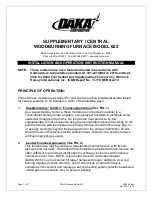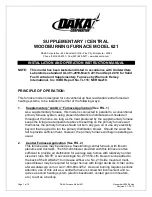
12
Vent/Flue Pipe & Combustion Air Pipe
This manual will refer to the pipe that discharges products
of combustion to the outdoors as the “vent” pipe or “flue”
pipe. The pipe that supplies air for combustion to the
furnace will be referred to as the “intake” pipe or “com-
bustion air” pipe. A condensing gas furnace achieves its high
level of efficiency by extracting almost all of the heat from the
products of combustion and cooling them to the point where
condensation takes place. Because of the relatively low flue gas
temperature and water condensation requirements, PVC or ABS
pipe is typically used as venting and intake pipe materials.
In Canada ABS is not an approved vent pipe material but it
is permissible to use as combustion air pipe material.
In addition to PVC and ABS pipe and fittings, Innoflue
®
by
Centrotherm Eco Systems and PolyPro
®
by M&G Duravent are
also approved vent and combustion air materials for instal-
lations in the U.S.A. and Canada. Manufacturers Installation
instructions for these products must be followed. These
products have specific instructions for installing, joining
and terminating. Do not mix materials or components of
one manufacturer with materials or components of another
manufacturer.
All furnaces are manufactured with 2” vent / intake pipe
and connectors. For furnaces requiring installation of 3”
pipe, the transition from 2” to 3” should be done as close
to the furnace as practically possible.
This furnace must not be connected to Type B, BW, or L
vent or vent connector, and must not be vented into any
portion of a factory built or masonry chimney except when
used as a pathway for PVC as described later in this section.
Never common vent this appliance with another appliance
or use a vent which is used by a solid fuel appliance. Do
not use commercially available “no hub connectors” other
than those shipped with this product.
It is the responsibility of the installer to follow the man-
ufacturers’ recommendations and to verify that all vent/
flue piping and connectors are compatible with furnace flue
products. Additionally, it is the responsibility of the installer
to ensure that all piping and connections possess adequate
structural integrity and support to prevent flue pipe sepa
-
ration, shifting, or sagging during furnace operation.
U
PON
COMPLETION
OF
THE
FURNACE
INSTALLATION
,
CAREFULLY
INSPECT
THE
ENTIRE
FLUE
SYSTEM
BOTH
INSIDE
AND
OUTSIDE
OF
THE
FURNACE
TO
ASSURE
IT
IS
PROPERLY
SEALED
. L
EAKS
IN
THE
FLUE
SYSTEM
CAN
RESULT
IN
SERIOUS
PERSONAL
INJURY
OR
DEATH
DUE
TO
EXPOSURE
TO
FLUE
PRODUCTS
,
INCLUDING
CARBON
MONOXIDE
.
WARNING
F
AILURE
TO
FOLLOW
THESE
INSTRUCTIONS
CAN
RESULT
IN
BODILY
INJURY
OR
DEATH
. C
AREFULLY
READ
AND
FOLLOW
ALL
INSTRUCTIONS
GIVEN
IN
THIS
SECTION
.
WARNING
Dual Certification: Non-Direct/Direct Vent
This furnace is dual certified and may be installed as a non-di
-
rect vent (single pipe) or direct vent (dual pipe) appliance. A
non-direct vent
installation requires only a vent/flue pipe,
while a
direct vent
installation requires both a vent/flue
pipe and a combustion air intake pipe. Refer to the ap-
propriate section for details concerning piping size, length,
number of elbows, furnace connections, and terminations.
Materials and Joining Methods
Two-three-inch nominal diameter PVC Schedule 40 pipe
meeting ASTM D1785, PVC primer meeting ASTM F656, and
PVC solvent cement meeting ASTM D2564 specifications
must be used. Fittings must be DWV type fittings meeting
ASTM D2665 and ASTM D3311. Carefully follow the man-
ufacturer’s instructions for cutting, cleaning, and solvent
cementing of PVC.
The use of Schedule 40 PVC cellular core DWV meeting
ASTM F891 or ABS cellular core (Foam Core) plastic pipe is
also acceptable as a flue/vent and intake pipe material.
PVC primer meeting ASTM F656 and PVC solvent cement
meeting ASTM D2564 specifications must be used. Fittings
must be DWV type fittings meeting ASTM D2665 and ASTM
D3311. Carefully follow the manufactures instructions for
cutting, cleaning and solvent cementing of PVC.
For Canadian installations; all PVC pipe, fittings and joining
materials must be UL S636 listed.
NOTE: Requirement does not apply to the combustion air
pipe.
As an alternative to PVC pipe, primer, solvent cement, and fit
-
tings, ABS materials which are in compliance with the following
specifications may be used. Two-or-three-inch ABS Schedule
40 pipe must meet ASTM D1527 and, if used in Canada, must
be CSA listed. Solvent cement for ABS to ABS joints must meet
ASTM D2235 and, if used in Canada, must be CSA listed. The
solvent cement for the PVC to ABS transition joint must meet
ASTM D3138. Fittings must be DWV type fittings meeting ASTM
D2661 and ASTM D3311 and, if used in Canada, must be CSA
listed. Carefully follow the manufacturers’ instructions for
cutting, cleaning, and solvent cementing PVC and/or ABS.
All 90° elbows must be medium radius (1/4 bend DWV) or long
radius (Long sweep 1/4 bend DWV) types conforming to ASTM
D3311. A medium radius (1/4 bend DWV) elbow measures 3
1/16” minimum from the plane of one opening to the center
line of the other opening for 2” diameter pipe, and 4 9/16”
minimum for 3” pipe.
Содержание Amana CES9 Series
Страница 54: ...54 THIS PAGE LEFT INTENTIONALLY BLANK...
Страница 55: ...55 THIS PAGE LEFT INTENTIONALLY BLANK...













































